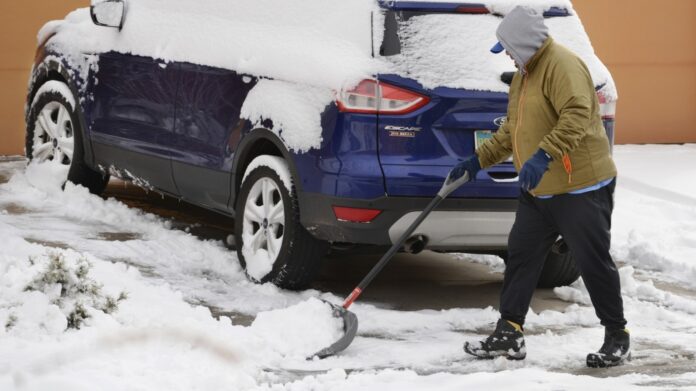There’s nothing like getting into a wreck before you leave your driveway, or sliding into your garage door like it’s home plate and you’re down by one run. Yes, winter provides plenty of reasons not to leave the house, and an icy driveway is one of them. But winter happens the same time every year, so surely you’re prepared with a bucket of deicing salt, right? Yeah, winter somehow catches us by surprise every year as well.
But there are things in your house right now you can use to take ice off your driveway. For example, did you know that you can use the solution in pickle jars to melt the ice from your driveway? Dish soap mixed with water and rubbing alcohol will do the trick, too. You know those coffee grounds left over after making your morning fuel? You’re letting them go to waste if you throw them away instead of using them to deice your driveway.
Do you have a fireplace or wood-burning stove? That leftover ash can help deice your driveway, so don’t think of it as something you have to dread cleaning. Think of it as collecting. And then there’s baking soda. Surely you have a box of that around the house, don’t you? Well, it also works pretty well. (Some localities have started using beet sugar instead of rock salt to deice their roads, but who has that lying around the house?)
So if you venture out of your house this winter and slip as soon as you step on to your driveway, don’t despair. Once you’ve gotten up, dusted yourself off, and checked to make sure no one was looking, just grab one of these handy items and get to deicing.
Rubbing alcohol, water, and dish soap
You may have especially traumatic memories of rubbing alcohol if you’re old enough. It’s what your mom would use on your cuts and scrapes back in the day, because apparently the right way to treat those injuries was to put something on them that would make them hurt even more. And then she would blow her germs on them — I mean, she’d kiss them — for good measure. (Sorry for venting here, but therapy is expensive.)
Anyway, you probably have rubbing alcohol in your medicine cabinet, and of course you have dish soap (we hope). Mixing a half-gallon of hot water with six drops of liquid dish soap and a quarter-cup of rubbing alcohol makes an effective solution for melting ice. Why? Anyone who has stored liquor in the freezer can tell you that alcohol’s freezing point is a lot lower than that of water. Anyone who has done this can also tell you that it makes your whiskey or tequila very smooth. But only put hard liquor in the freezer, not beer or wine. What were we talking about? Right, icy driveways!
The rubbing alcohol’s low freezing point drags down the freezing point of water. The soap is there to help spread the vinegar over the ice. And the hot water heats up the ice, helping it to melt faster.
Save up your pickle juice
You know that leftover liquid in your jar of dill pickles? Every source we could find that sounds like they know what they’re talking about calls it “pickle brine.” But you and we know it’s really called “pickle juice.” It has a name, people, use it! Well, whatever you call it, it can be pretty useful for removing ice from your driveway. Evidently, “pickle brine” might be good at removing ice from streets, too, because New Jersey and other states have been experimenting with it on their roads.
The reason pickle juice is good for this is because it is basically vinegar, salt, and sugar. Those ingredients are all effective at deicing, especially when they’re combined. Vinegar’s freezing point is slightly lower than that of water, so it lowers water’s freezing temperature, causing it to melt. Salt and sugar do the same thing. Salt has the added advantage in that it creates saltwater when mixing with melting ice, making it harder to refreeze. Combine these three ingredients into a brine and you get a mixture that can melt ice even when it’s as cold as minus 6 degrees. Spray it on your driveway the night before an expected freeze, and it can help prevent ice from forming.
So save that pickle juice instead of throwing it away. That might be a challenge for some people. There are those who like to sip pickle juice from the jar, or, uh, so we’re told. It’s not like we would ever do anything like that. But if you have a taste for pickle squeezings, you might need to exercise your self-control to save some for winter.
Put your coffee addiction to good use
It turns out that coffee is good for more than keeping you conscious during office hours and making you tolerable to your coworkers, or making your coworkers tolerable to you, depending on how you think about it. Coffee grounds are good at absorbing heat from the sun. Spread some coffee grounds over icy patches on your driveway and the sun will warm them up, which will help to melt the ice. Coffee grounds also contain nitrogen, which can lower water’s melting point. But mostly, coffee grounds are good for providing traction on ice and snow, more than actually melting ice. For best results, you’ll want to do this right after making coffee on a sunny day.
This isn’t just some quirky DIY idea submitted by a random blogger. Some Scandinavian cities have been using coffee grounds on icy streets for a while. And the city of Krakow, Poland has instituted a program in which it’s experimenting with spreading coffee grounds on sidewalks in city parks. City workers collect used coffee grounds from local cafes. So far, more than 50 cafes have applied to be part of the program.
Fresh warm coffee grounds are best for this purpose, so you’d have to drink a lot of coffee to cover a whole driveway. Some of you are thinking, “Challenge accepted!” A few of you may already drink enough coffee to do that. If so, please, get help.
Don’t throw that wood ash away
Do you have a fireplace? Do you use a wood-burning stove? Do you host bonfires for mysterious rituals? (We don’t judge!) If any of these are true, you have to deal with wood ash, which is no fun at all to clean up. But don’t just throw it away. It can help you with deicing your driveway.
Wood ash contains potassium salts, which can lower water’s melting point and help melt ice. And if the sun is out, all the better, as the ash will warm up, which helps to melt ice as well. Wood ash is also good for providing instant traction. But while the traction may be instant, it takes some time for wood ash to melt ice. Expect to wait hours to see results.
There is the cleanup to consider, as well. Wood ash loves to stick to shoes, and this is one thing you do not want to track inside the house. Picturing what wood ash would look like smeared across our carpets is enough to make us pass on this homemade deicing solution. But if you think you can handle the mess, it might be something to consider.
Good old baking soda
Baking soda is the Swiss Army Knife of, well, powders that come in little cardboard boxes. It can be used to deodorize your fridge or cabinet, remove coffee stains, soothe bug bites, clean your microwave, put out small grease fires, and as a dry shampoo. Some people even use it for, get this, baking. But there is yet another use for this amazing miracle product, which is, you guessed it, deicing your driveway.
The scientific name for baking soda is sodium bicarbonate, which means it is a kind of salt. And we know what salt does to ice. One of the advantages of baking soda compared with some other homemade deicers is that it doesn’t necessarily have to be mixed with anything, especially if you’re dealing with just a thin layer of ice. You can spread it directly on the ice and it will start melting. You have to be patient, though, since baking soda can take a while to do its thing. To speed up the process, especially on thicker ice, you could mix it with some warm water to jump-start the process.
Another good thing about baking soda is that it’s less alkaline than the salt that is commonly used for deicing a sidewalk or street. That means it is a lot gentler on bricks and concrete.
There are tons of ways you can deice your driveway using things that are probably already in your house. We’ve really only scratched the surface here. So don’t panic if you’re out of rock salt. You have options. And if you do make it out of your driveway, check out these tips for winter driving.



